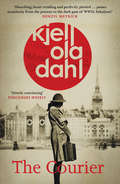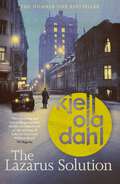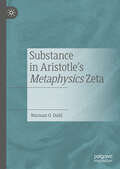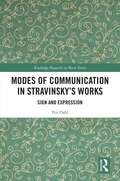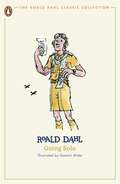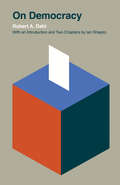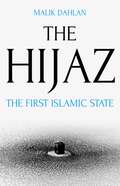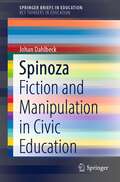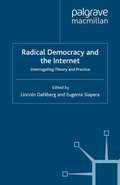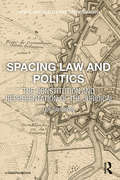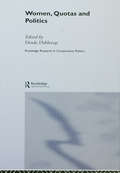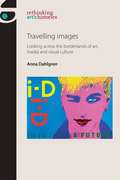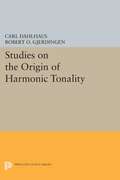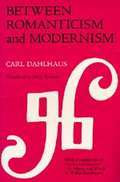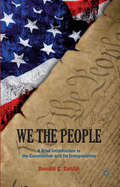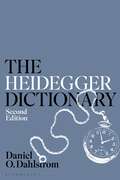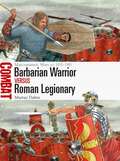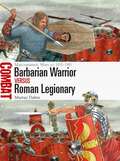- Table View
- List View
The Art of the Blues: A Visual Treasury of Black Music's Golden Age
by Bill DahlThis stunning book charts the rich history of the blues, through the dazzling array of posters, album covers, and advertisements that have shaped its identity over the past hundred years. The blues have been one of the most ubiquitous but diverse elements of American popular music at large, and the visual art associated with this unique sound has been just as varied and dynamic. There is no better guide to this fascinating graphical world than Bill Dahl—a longtime music journalist and historian who has written liner notes for countless reissues of classic blues, soul, R&B, and rock albums. With his deep knowledge and incisive commentary—complementing more than three hundred and fifty lavishly reproduced images—the history of the blues comes musically and visually to life. What will astonish readers who thumb through these pages is the amazing range of ways that the blues have been represented—whether via album covers, posters, flyers, 78 rpm labels, advertising, or other promotional materials. We see the blues as it was first visually captured in the highly colorful sheet music covers of the early twentieth century. We see striking and hard-to-find label designs from labels big (Columbia) and small (Rhumboogie). We see William Alexander’s humorous artwork on postwar Miltone Records; the cherished ephemera of concert and movie posters; and Chess Records’ iconic early albums designed by Don Bronstein, which would set a new standard for modern album cover design. What these images collectively portray is the evolution of a distinctively American art form. And they do so in the richest way imaginable. The result is a sumptuous book, a visual treasury as alive in spirit as the music it so vibrantly captures.
The Courier
by Kjell Ola DahlThe international bestselling godfather of Nordic Noir takes on one of the most horrific periods of modern history, in a stunning standalone thriller … NUMBER ONE BESTSELLER‘The Courier is a stylish stand-alone thriller from the godfather of Scandi noir … Ola Dahl ratchets up the tension from the first pages and never lets go’ The Times‘Cleverly braiding together past and present, the who and why of murder and betrayal are unpicked. The detail is impressive’ Daily MailIn 1942, Jewish courier Ester is betrayed, narrowly avoiding arrest by the Gestapo. In a great haste, she escapes to Sweden, saving herself. Her family in Oslo, however, is deported to Auschwitz. In Stockholm, Ester meets the resistance hero, Gerhard Falkum, who has left his little daughter and fled both the Germans and allegations that he murdered his wife, Åse, who helped Ester get to Sweden. Their burgeoning relationship ends abruptly when Falkum dies in a fire.And yet, twenty-five years later, Falkum shows up in Oslo. He wants to reconnect with his daughter. But where has he been, and what is the real reason for his return? Ester stumbles across information that forces her to look closely at her past, and to revisit her war-time training to stay alive…Written with Dahl's trademark characterization and elegant plotting, The Courier sees the hugely respected godfather of Nordic Noir at his best, as he takes on one of the most horrific periods of modern history, in an exceptional, shocking thriller.‘Absorbing, heart-rending and perfectly plotted. Kjell Ola Dahl’s The Courier passes seamlessly from the present to the dark past of WWII. Fabulous!’ Denzil Meyrick‘Skilfully juggling three Oslo timelines — in 1942, 1967 and 2015 — Dahl starts his story with Germany’s occupation of Norway and the work of those who tried to resist, then brings his characters forward to a post-war unravelling of what really happened in those dangerous days — and the traumatic rewriting of personal stories’ The Times Crime Club‘The Courier is very good on the socio-political situation of the time, the relationship between Norway and neutral neighbour Sweden. This is a gritty but ultimately uplifting story. Superbly translated by Don Bartlett’ NB Magazine‘A fascinating, intricate, provocative read, set in motion by events in 1942, and brilliantly highlighting human need and emotions … ‘The Courier’ sent a shiver coursing through me, it is a truly eloquent and rewarding tale, and oh that ending!’ LoveReading‘Written with Dahl’s trademark characterisation and clever plotting, The Courier sees one of Norway’s most critically acclaimed authors at his best … This stunning and compelling wartime thriller is reminiscent of the writing of John Le Carré and William Boyd’ New Books Magazine‘Utterly convincing’ Publishers Weekly‘Kjell Ola Dahl’s novels are superb. If you haven’t read one, you need to – right now’ William Ryan‘More than gripping’ European Literature Network‘The perfect example of why Nordic Noir has become such a popular genre’ Reader’s Digest‘It all comes together, of course, in the kind of masterful, detailed plotting that Dahl is known for … the power of The Courier is how Dahl has given a complex, human face to such an inhuman tragedy’ Crime Fiction Lover‘Atmospheric thriller with lots of great twists and loved the scandi wartime story in particular. Gripping will be recommending to readers’ Edgy Books
The Lazarus Solution: The compulsive, breathtaking new historical thriller from the Godfather of Nordic Noir
by Kjell Ola DahlWhen a courier for Sweden’s Press and Military Office is killed on his final mission, the Norwegian government-in-exile appoints a writer to find the missing documents … breathtaking WW2 thriller.**International NUMBER ONE bestseller**‘A stylish stand-alone thriller from the godfather of Scandi noir … Ola Dahl ratchets up the tension from the first pages and never lets go' Sunday Times'Absorbing, heart-rending and perfectly plotted' Denzil Meyrick‘Expertly crafted’ John Harvey_________Summer, 1943. Daniel Berkåk works as a courier for the Press and Military Office in Stockholm. On his last cross-border mission to Norway, he carries a rucksack full of coded documents and newspapers, but before he has a chance to deliver anything he is shot and killed and the contents of his rucksack are missing.The Norwegian government, currently exiled in London, wants to know what happened, and the job goes to writer Jomar Kraby,whose first suspect is a Norwegian refugee living in Sweden, whose past that is as horrifying as the events still to come...Both classic crime and a stunning expose of Norwegian agents in Stockholm during the Second World War, The Lazarus Solution is a compulsive, complex, richly authentic historical thriller from one of the godfathers of Nordic Noir.For fans of Sebastian Faulks, Lars Mytting, Mick Herron and Robert Harris._______‘The detail is impressive' Daily Mail'Kjell Ola Dahl's novels are superb. If you haven't read one, you need to right now' William Ryan'A dark but richly described backdrop and a relentless, underlying tension … Fans of Nordic noir will be satisfied' Publishers Weekly
Substance in Aristotle's Metaphysics Zeta
by Norman O. DahlThis book argues that according to Metaphysics Zeta, substantial forms constitute substantial being in the sensible world, and individual composites make up the basic constituents that possess this kind of being. The study explains why Aristotle provides a reexamination of substance after the Categories, Physics, and De Anima, and highlights the contribution Z is meant to make to the science of being. Norman O. Dahl argues that Z.1-11 leaves both substantial forms and individual composites as candidates for basic constituents, with Z.12 being something that can be set aside. He explains that although the main focus of Z.13-16 is to argue against a Platonic view that takes universals to be basic constituents, some of its arguments commit Aristotle to individual composites as basic constituents, with Z.17’s taking substantial form to constitute substantial being is compatible with that commitment. .
Modes of Communication in Stravinsky’s Works: Sign and Expression (Routledge Research in Music)
by Per DahlIgor Stravinsky left behind a complex heritage of music and ideas. There are many examples of discrepancies between his literate statements about music and musicians and his musical compositions and activity. Per Dahl presents a model of communication that unveils a clear and logical understanding of Stravinsky's heritage, based on the extant material available. From this, Dahl argues the case for Stravinsky’s music and his ideas as separate entities, representing different modes of communication. As well as describing a triangular model of communication, based on a tilted and extended version of Ogden's triangle, Dahl presents an empirical investigation of Stravinsky's vocabulary of signs and expressions in his published scores - his communicative mode towards musicians. In addition to simple statistics, Dahl compares the notation practice in the composer’s different stylistic epochs as well as his writing for different sizes of ensembles. Dahl also considers Stravinsky’s performances and recordings as modes of communication to investigate whether the multi-layered model can soften the discrepancies between Stravinsky the literate and Stravinsky the musician.
Modes of Communication in Stravinsky’s Works: Sign and Expression (Routledge Research in Music)
by Per DahlIgor Stravinsky left behind a complex heritage of music and ideas. There are many examples of discrepancies between his literate statements about music and musicians and his musical compositions and activity. Per Dahl presents a model of communication that unveils a clear and logical understanding of Stravinsky's heritage, based on the extant material available. From this, Dahl argues the case for Stravinsky’s music and his ideas as separate entities, representing different modes of communication. As well as describing a triangular model of communication, based on a tilted and extended version of Ogden's triangle, Dahl presents an empirical investigation of Stravinsky's vocabulary of signs and expressions in his published scores - his communicative mode towards musicians. In addition to simple statistics, Dahl compares the notation practice in the composer’s different stylistic epochs as well as his writing for different sizes of ensembles. Dahl also considers Stravinsky’s performances and recordings as modes of communication to investigate whether the multi-layered model can soften the discrepancies between Stravinsky the literate and Stravinsky the musician.
Going Solo: The Centenary Collection (The Roald Dahl Classic Collection)
by Roald DahlIt was truly the most breathless and in a way the most exhilarating time I have ever had in my life.This beautiful edition of Going Solo, part of The Roald Dahl Classic Collection, features official archive material from the Roald Dahl Museum and is perfect for Dahl fans old and new.So, enter a world where invention and mischief can be found on every page and where magic might be at the very tips of your fingers . . .The Roald Dahl Classic Collection reinstates the versions of Dahl’s books that were published before the 2022 Puffin editions, aimed at newly independent young readers.
On Democracy: Second Edition (Veritas Paperbacks)
by Robert A. DahlWritten by the preeminent democratic theorist of our time, this book explains the nature, value, and mechanics of democracy. In a new introduction to this Veritas edition, Ian Shapiro considers how Dahl would respond to the ongoing challenges democracy faces in the modern world. “Within the liberal democratic camp there is considerable controversy about exactly how to define democracy. Probably the most influential voice among contemporary political scientists in this debate has been that of Robert Dahl.”—Marc Plattner, New York Times “An excellent introduction for novices, as well as a trusty handbook for experts and political science mavens.”—Publishers Weekly
The Hijaz: The First Islamic State
by Malik DahlanDahlan offers an alternative vision of Islamic governance through the history and promise of the Hijaz, the first state of Islam. The Hijaz, in the west of present-day Saudi Arabia, was the first Islamic state in Mecca and Medina. This new interpretative history offers a fresh vision of Islamic governance and law as a positive force for political reform in the Middle East and beyond. Applying key Islamic principles of public good to contemporary life, Malik Dahlan challenges two dominant narratives. He reclaims the development of Islamic statecraft as the wellspring of collective identity and statesmanship in the Arab world, simultaneously influenced and disrupted by Westphalian statehood models and Enlightenment notions of self-determination. He equally rejects the appropriation of Islamic governance and the Caliphate concept by both the post-modern, non-territorial Al-Qaeda and the neo-medievalist ISIS. Celebrating the history and untapped potential of a region where Arab leaders built the ideological foundations of an emerging polity, The Hijaz is a compelling alternative analysis of governance in the Arabian Peninsula and the global Islamic community, and of its interaction with the wider world.
The Hijaz: The First Islamic State
by Malik DahlanDahlan offers an alternative vision of Islamic governance through the history and promise of the Hijaz, the first state of Islam. The Hijaz, in the west of present-day Saudi Arabia, was the first Islamic state in Mecca and Medina. This new interpretative history offers a fresh vision of Islamic governance and law as a positive force for political reform in the Middle East and beyond. Applying key Islamic principles of public good to contemporary life, Malik Dahlan challenges two dominant narratives. He reclaims the development of Islamic statecraft as the wellspring of collective identity and statesmanship in the Arab world, simultaneously influenced and disrupted by Westphalian statehood models and Enlightenment notions of self-determination. He equally rejects the appropriation of Islamic governance and the Caliphate concept by both the post-modern, non-territorial Al-Qaeda and the neo-medievalist ISIS. Celebrating the history and untapped potential of a region where Arab leaders built the ideological foundations of an emerging polity, The Hijaz is a compelling alternative analysis of governance in the Arabian Peninsula and the global Islamic community, and of its interaction with the wider world.
Spinoza: Fiction and Manipulation in Civic Education (SpringerBriefs in Education)
by Johan DahlbeckThis book is a philosophical enquiry into the educational consequences of Spinoza’s political theory. Spinoza’s political theory is of particular interest for educational thought as it brings together the normative aims of his ethical theory with his realistic depiction of human psychology and the ramifications of this for successful political governance. As such, this book aims to introduce the reader to Spinoza’s original vision of civic education, as a project that ultimately aims at the ethical flourishing of individuals, while being carefully tailored and adjusted to the natural limitations of human reason. Readers will benefit from a succinct introduction to Spinoza’s political philosophy and from an account of civic education that is based on careful exegetical work. It draws conclusions only hinted at in Spinoza’s own writings.
Radical Democracy and the Internet: Interrogating Theory and Practice
by L. Dahlberg E. SiaperaIn this systematic and mutual interrogation of radical democratic theory and Internet practice, contributors examine a range of democratic theories in relation to online communication and explore how such communication may advance democracy beyond what is conceptualized and practised within present liberal-capitalist political contexts.
Spacing Law and Politics: The Constitution and Representation of the Juridical
by Leif DahlbergExamining the inherent spatiality of law, both theoretically and as social practice, this book presents a genealogical account of the emergence and the development of the juridical. In an analysis that stretches from ancient Greece, through late antiquity and early modern and modern Europe, and on to the contemporary courtroom, it considers legal and philosophical texts, artistic and literary works, as well as judicial practices, in order to elicit and document a series of critical moments in the history of juridical space. Offering a more nuanced understanding of law than that found in traditional philosophical, political or social accounts of legal history, Dahlberg forges a critical account of the intimate relations between law and politics that shows how juridical space is determined and conditioned in ways that are integral to the very functioning – and malfunctioning – of law.
Spacing Law and Politics: The Constitution and Representation of the Juridical
by Leif DahlbergExamining the inherent spatiality of law, both theoretically and as social practice, this book presents a genealogical account of the emergence and the development of the juridical. In an analysis that stretches from ancient Greece, through late antiquity and early modern and modern Europe, and on to the contemporary courtroom, it considers legal and philosophical texts, artistic and literary works, as well as judicial practices, in order to elicit and document a series of critical moments in the history of juridical space. Offering a more nuanced understanding of law than that found in traditional philosophical, political or social accounts of legal history, Dahlberg forges a critical account of the intimate relations between law and politics that shows how juridical space is determined and conditioned in ways that are integral to the very functioning – and malfunctioning – of law.
Women, Quotas And Politics (Routledge Research In Comparative Politics #No. 10)
by Drude DahlerupThis is the first world-wide, comparative study of the controversial new trends of gender quotas now emerging in global politics, presenting a comprehensive overview of changes in women's parliamentary representation across the world. This is important reading for all those working to increase women's influence in politics, because it scrutinizes under what circumstances gender quotas do increase women's representation - and why they sometimes fail. These distinguished international scholars also show how gender balance in politics has become important to a nation's international image and why quotas are being introduced in many post-conflict countries. They present key case studies of Afghanistan, Iraq, Argentina, Sweden, South Africa, Belgium, covering almost all major regions of the world: Latin America, Africa, the Arab world, South Asia, the Balkans, The Nordic countries and Europe, New Zealand, Australia and the USA - and Rwanda, which in 2003 unexpectedly surpassed Sweden as the number one country in the world in terms of women's parliamentary representation. Using a comparative perspective, this book contains analyses of the discursive controversies around quotas; it gives an overview over various types of quotas in use from candidate quotas to reserved seat systems, and it throws light over the troublesome implementation process. When do gender quotas lead to actual increase in the number of women parliament? When are quotas merely a symbolic gesture? What does it imply to be elected as a 'quota woman'? Tackling these and many more key questions, this is a major new contribution to the field. Making an important contribution to our knowledge of gender politics worldwide, this book will be of interest to NGOs, students and scholars of democracy, policy-making, comparative politics and gender studies.
Women, Quotas And Politics (Routledge Research In Comparative Politics #No. 10)
by Drude DahlerupThis is the first world-wide, comparative study of the controversial new trends of gender quotas now emerging in global politics, presenting a comprehensive overview of changes in women's parliamentary representation across the world. This is important reading for all those working to increase women's influence in politics, because it scrutinizes under what circumstances gender quotas do increase women's representation - and why they sometimes fail. These distinguished international scholars also show how gender balance in politics has become important to a nation's international image and why quotas are being introduced in many post-conflict countries. They present key case studies of Afghanistan, Iraq, Argentina, Sweden, South Africa, Belgium, covering almost all major regions of the world: Latin America, Africa, the Arab world, South Asia, the Balkans, The Nordic countries and Europe, New Zealand, Australia and the USA - and Rwanda, which in 2003 unexpectedly surpassed Sweden as the number one country in the world in terms of women's parliamentary representation. Using a comparative perspective, this book contains analyses of the discursive controversies around quotas; it gives an overview over various types of quotas in use from candidate quotas to reserved seat systems, and it throws light over the troublesome implementation process. When do gender quotas lead to actual increase in the number of women parliament? When are quotas merely a symbolic gesture? What does it imply to be elected as a 'quota woman'? Tackling these and many more key questions, this is a major new contribution to the field. Making an important contribution to our knowledge of gender politics worldwide, this book will be of interest to NGOs, students and scholars of democracy, policy-making, comparative politics and gender studies.
Travelling images: Looking across the borderlands of art, media and visual culture (Rethinking Art's Histories)
by Anna DahlgrenThis book critically examines images in the borderlands of the art world, investigating relations between visual art and vernacular visual culture within different images communities from the 1870s to the present day. It concentrates on the mechanisms of such processes and their implications for the understanding of art and art-historical narratives. Merging perspectives from art history and visual culture studies with media studies, it fills a gap in the field of visual studies through its use of a diversity of images as prime sources. Where textual statements are scarce the book maps visual statements instead, demonstrating the potential of image studies. Consequently, it will be of great relevance to those interested in art and visual culture in modernity, as well as discourses of the notion of art and art history writing.
Travelling images: Looking across the borderlands of art, media and visual culture (Rethinking Art's Histories)
by Anna DahlgrenThis book critically examines images in the borderlands of the art world, investigating relations between visual art and vernacular visual culture within different images communities from the 1870s to the present day. It concentrates on the mechanisms of such processes and their implications for the understanding of art and art-historical narratives. Merging perspectives from art history and visual culture studies with media studies, it fills a gap in the field of visual studies through its use of a diversity of images as prime sources. Where textual statements are scarce the book maps visual statements instead, demonstrating the potential of image studies. Consequently, it will be of great relevance to those interested in art and visual culture in modernity, as well as discourses of the notion of art and art history writing.
Studies on the Origin of Harmonic Tonality
by Carl Dahlhaus Robert O. GjerdingenCarl Dahlhaus was without doubt the premier musicologist of the postwar generation, a giant whose recent death was mourned the world over. Translated here for the first time, this fundamental work on the development of tonality shows his complete mastery of the theory of harmony. In it Dahlhaus explains the modern concepts of harmony and tonality, reviewing in the process the important theories of Rameau, Sechter, Ftis, Riemann, and Schenker. He contrasts the familiar premises of chordal composition with the lesser known precepts of intervallic composition, the basis for polyphonic music in the late Middle Ages and Renaissance. Numerous quotations from theoretical treatises document how early music was driven forward not by progressions of chords but by simple progressions of intervals.Exactly when did composers transform intervallic composition into chordal composition? Modality into tonality? Dahlhaus provides extensive analyses of motets by Josquin, frottole by Cara and Tromboncino, and madrigals by Monteverdi to demonstrate how, and to what degree, such questions can be answered. In his bold speculations, in his magisterial summaries, in his command of eight centuries of music and writings on music, and in his deep understanding of European history and culture, Carl Dahlhaus sets a standard that will seldom be equalled.Originally published in 1990.The Princeton Legacy Library uses the latest print-on-demand technology to again make available previously out-of-print books from the distinguished backlist of Princeton University Press. These editions preserve the original texts of these important books while presenting them in durable paperback and hardcover editions. The goal of the Princeton Legacy Library is to vastly increase access to the rich scholarly heritage found in the thousands of books published by Princeton University Press since its founding in 1905.
Between Romanticism and Modernism: Four Studies in the Music of the Later Nineteenth Century (California Studies In 19th-century Music #1)
by Carl Dahlhaus Mary WhittallCarl Dahlhaus here treats Nietzsche's youthful analysis of the contradictions in Wagner's doctrine (and, more generally, in romantic musical aesthetics); the question of periodicization in romantic and neo-romantic music; the underlying kinship between Brahms's and Wagner's responses to the central musical problems of their time; and the true significance of musical nationalism. Included in this volume is Walter Kauffman's translation of the previously unpublished fragment, "On Music and Words," by the young Nietzsche.
We the People: A Brief Introduction to the Constitution and Its Interpretation
by D. DahlinDahlin takes an analytical approach to existing Constitutional scholarship and presents a limited number of landmark Supreme Court decisions in a way that makes this important material accessible to an undergraduate academic audience.
The Heidegger Dictionary (Bloomsbury Philosophy Dictionaries)
by Daniel O. DahlstromWhat does Heidegger mean by 'Dasein'? What does he say in Being and Time? How does his phenomenology differ to that of his teacher, Husserl? Answering these questions and more, The Heidegger Dictionary provides students with all the tools they need to better understand one of the most influential yet complex philosophers of the 20th century. Easy to use and navigate, this book is divided into four main parts, covering Heidegger's life, ideas and innovative terminology, related thinkers, and published and unpublished works. Updated with significant new material throughout, the 2nd edition has been expanded to engage with the latest Heidegger scholarship, and features:· A new A-Z section on Heidegger's influences, contemporaries, and commentators, from Martin Luther to Hannah Arendt and Jean-Paul Sartre· Summaries of Heidegger's entire 102-volume Collected Works, including the Black Notebooks · Expanded coverage of Heidegger's thought, with straightforward explanations of his views on modernity, science and more · An updated glossary of Heidegger's key terms, listing all the major translation alternatives alongside his original GermanProviding a road-map to how Heidegger's ideas developed over his long philosophical career, this is an essential research companion for all students of Heidegger, from beginners to the advanced.
The Heidegger Dictionary (Bloomsbury Philosophy Dictionaries)
by Professor Daniel O. DahlstromWhat does Heidegger mean by 'Dasein'? What does he say in Being and Time? How does his phenomenology differ to that of his teacher, Husserl? Answering these questions and more, The Heidegger Dictionary provides students with all the tools they need to better understand one of the most influential yet complex philosophers of the 20th century. Easy to use and navigate, this book is divided into four main parts, covering Heidegger's life, ideas and innovative terminology, related thinkers, and published and unpublished works. Updated with significant new material throughout, the 2nd edition has been expanded to engage with the latest Heidegger scholarship, and features:· A new A-Z section on Heidegger's influences, contemporaries, and commentators, from Martin Luther to Hannah Arendt and Jean-Paul Sartre· Summaries of Heidegger's entire 102-volume Collected Works, including the Black Notebooks · Expanded coverage of Heidegger's thought, with straightforward explanations of his views on modernity, science and more · An updated glossary of Heidegger's key terms, listing all the major translation alternatives alongside his original GermanProviding a road-map to how Heidegger's ideas developed over his long philosophical career, this is an essential research companion for all students of Heidegger, from beginners to the advanced.
Barbarian Warrior vs Roman Legionary: Marcomannic Wars AD 165–180 (Combat #76)
by Dr Murray DahmThis engrossing book pits the legionaries of Imperial Rome against their Germanic and Sarmatian opponents in the 2nd century AD.Shortly after Marcus Aurelius came to power in AD 161, the Roman Empire was racked by a series of military crises. While unrest in Britain and a new war with Parthia were swiftly dealt with, the invasion of Roman territory by the Chatti and Chauci peoples heralded a resurgent threat from the empire's European neighbours. Soon the Marcomanni and the Quadi, as well as the Dacians and the Sarmatian Iazyges, would attack the Romans in a series of savage conflicts that continued until AD 175 and would see the first invasion of Roman Italy since the beginning of the 1st century BC.In this book, the two sides' objectives, weapons and equipment and fighting styles are assessed and compared in the context of three featured battles: Carnuntum (170), where a Roman legion was vanquished and Italy invaded; the 'Battle on the Ice' (172), where the Romans fought their lighter-armed Iazyges opponents on the frozen Danube; and the so-called 'Miracle of the Rain' (174), during which a trapped Roman force facing annihilation was able to defeat numerically superior Germanic forces. Photographs, specially commissioned artwork plates and mapping complement the authoritative text in this engrossing study of Imperial Rome at war.
Barbarian Warrior vs Roman Legionary: Marcomannic Wars AD 165–180 (Combat #76)
by Dr Murray DahmThis engrossing book pits the legionaries of Imperial Rome against their Germanic and Sarmatian opponents in the 2nd century AD.Shortly after Marcus Aurelius came to power in AD 161, the Roman Empire was racked by a series of military crises. While unrest in Britain and a new war with Parthia were swiftly dealt with, the invasion of Roman territory by the Chatti and Chauci peoples heralded a resurgent threat from the empire's European neighbours. Soon the Marcomanni and the Quadi, as well as the Dacians and the Sarmatian Iazyges, would attack the Romans in a series of savage conflicts that continued until AD 175 and would see the first invasion of Roman Italy since the beginning of the 1st century BC.In this book, the two sides' objectives, weapons and equipment and fighting styles are assessed and compared in the context of three featured battles: Carnuntum (170), where a Roman legion was vanquished and Italy invaded; the 'Battle on the Ice' (172), where the Romans fought their lighter-armed Iazyges opponents on the frozen Danube; and the so-called 'Miracle of the Rain' (174), during which a trapped Roman force facing annihilation was able to defeat numerically superior Germanic forces. Photographs, specially commissioned artwork plates and mapping complement the authoritative text in this engrossing study of Imperial Rome at war.

